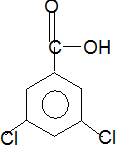
General, Organic, and Biological Chemistry: Structures of Life (5th Edition)
5th Edition
ISBN: 9780321967466
Author: Karen C. Timberlake
Publisher: PEARSON
expand_more
expand_more
format_list_bulleted
Concept explainers
Question
Chapter 16, Problem 16.48AQAP
Interpretation Introduction
a) To determine: The IUPAC name of the following compound

The IUPAC name is
Interpretation Introduction
b) To determine: The IUPAC name of the following compound

The IUPAC name is
Interpretation Introduction
c) To determine: The IUPAC name of the following compound

The IUPAC name is
Interpretation Introduction
d) To determine: The IUPAC name of the following compound

The IUPAC name is
Interpretation Introduction
e) To determine: The IUPAC name of the following compound

The IUPAC name is
Interpretation Introduction
f) To determine: The IUPAC name of the following compound

The IUPAC name is
Expert Solution & Answer
Want to see the full answer?
Check out a sample textbook solution
Students have asked these similar questions
First image: Why can't the molecule C be formed in those conditions
Second image: Synthesis for lactone C
its not an exam
First image: I have to show the mecanism for the reaction on the left, where the alcohol A is added fast in one portion
Second image: I have to show the mecanism of the reaction at the bottom. Also I have to show by mecanism why the reaction wouldn't work if the alcohol was primary
First image: I have to explain why the molecule C is never formed in those conditions.
Second image: I have to propose a synthesis for the lactone A
Chapter 16 Solutions
General, Organic, and Biological Chemistry: Structures of Life (5th Edition)
Ch. 16.1 - What carboxylic acid is responsible for the pain...Ch. 16.1 - What carboxylic acid is found in vinegar?Ch. 16.1 - Prob. 16.3QAPCh. 16.1 - Draw the condensed structural formula and give the...Ch. 16.1 - Prob. 16.5QAPCh. 16.1 - Prob. 16.6QAPCh. 16.1 - Draw the condensed structural formula for each of...Ch. 16.1 - Prob. 16.8QAPCh. 16.1 - Prob. 16.9QAPCh. 16.1 - Prob. 16.10QAP
Ch. 16.2 - Prob. 16.11QAPCh. 16.2 - Prob. 16.12QAPCh. 16.2 - Prob. 16.13QAPCh. 16.2 - Prob. 16.14QAPCh. 16.2 - Prob. 16.15QAPCh. 16.2 - Prob. 16.16QAPCh. 16.2 - Prob. 16.17QAPCh. 16.2 - Prob. 16.18QAPCh. 16.2 - Prob. 16.19QAPCh. 16.2 - Prob. 16.20QAPCh. 16.3 - Prob. 16.21QAPCh. 16.3 - Prob. 16.22QAPCh. 16.3 - Prob. 16.23QAPCh. 16.3 - Prob. 16.24QAPCh. 16.3 - Prob. 16.25QAPCh. 16.3 - Prob. 16.26QAPCh. 16.3 - 16.27 Give the IUPAC and common names,if any, of...Ch. 16.3 - Prob. 16.28QAPCh. 16.4 - Prob. 16.29QAPCh. 16.4 - Prob. 16.30QAPCh. 16.4 - Prob. 16.31QAPCh. 16.4 - Prob. 16.32QAPCh. 16.4 - Prob. 16.33QAPCh. 16.4 - Prob. 16.34QAPCh. 16.5 - Prob. 16.35QAPCh. 16.5 - Prob. 16.36QAPCh. 16.5 - Prob. 16.37QAPCh. 16.5 - Prob. 16.38QAPCh. 16.5 - Prob. 16.39QAPCh. 16.5 - Prob. 16.40QAPCh. 16 - Prob. 16.41UTCCh. 16 - Prob. 16.42UTCCh. 16 - Prob. 16.43UTCCh. 16 - Prob. 16.44UTCCh. 16 - Prob. 16.45UTCCh. 16 - Prob. 16.46UTCCh. 16 - Give the IUPAC and common names, if any, for each...Ch. 16 - Prob. 16.48AQAPCh. 16 - Prob. 16.49AQAPCh. 16 - Prob. 16.50AQAPCh. 16 - Prob. 16.51AQAPCh. 16 - Prob. 16.52AQAPCh. 16 - Prob. 16.53AQAPCh. 16 - Prob. 16.54AQAPCh. 16 - Prob. 16.55AQAPCh. 16 - Prob. 16.56AQAPCh. 16 - Prob. 16.57AQAPCh. 16 - Prob. 16.58AQAPCh. 16 - Prob. 16.59AQAPCh. 16 - Prob. 16.60AQAPCh. 16 - Prob. 16.61AQAPCh. 16 - Prob. 16.62AQAPCh. 16 - Prob. 16.63AQAPCh. 16 - Prob. 16.64AQAPCh. 16 - Prob. 16.65CQCh. 16 - Prob. 16.66CQCh. 16 - Prob. 16.67CQCh. 16 - Prob. 16.68CQCh. 16 - Prob. 16.69CQCh. 16 - Prob. 16.70CQ
Knowledge Booster
Learn more about
Need a deep-dive on the concept behind this application? Look no further. Learn more about this topic, chemistry and related others by exploring similar questions and additional content below.Similar questions
- 20.44 The Diels-Alder reaction is not limited to making six-membered rings with only car- bon atoms. Predict the products of the following reactions that produce rings with atoms other than carbon in them. OCCH OCCH H (b) CH C(CH₂)s COOCH མ་ནས་བ (c) N=C H -0.X- (e) H C=N COOCHS + CH2=CHCH₂ →→arrow_forwardGiven the attached data, provide the drawing for the corresponding structure.arrow_forwardno Ai walkthroughsarrow_forward
arrow_back_ios
SEE MORE QUESTIONS
arrow_forward_ios
Recommended textbooks for you
 ChemistryChemistryISBN:9781305957404Author:Steven S. Zumdahl, Susan A. Zumdahl, Donald J. DeCostePublisher:Cengage Learning
ChemistryChemistryISBN:9781305957404Author:Steven S. Zumdahl, Susan A. Zumdahl, Donald J. DeCostePublisher:Cengage Learning ChemistryChemistryISBN:9781259911156Author:Raymond Chang Dr., Jason Overby ProfessorPublisher:McGraw-Hill Education
ChemistryChemistryISBN:9781259911156Author:Raymond Chang Dr., Jason Overby ProfessorPublisher:McGraw-Hill Education Principles of Instrumental AnalysisChemistryISBN:9781305577213Author:Douglas A. Skoog, F. James Holler, Stanley R. CrouchPublisher:Cengage Learning
Principles of Instrumental AnalysisChemistryISBN:9781305577213Author:Douglas A. Skoog, F. James Holler, Stanley R. CrouchPublisher:Cengage Learning Organic ChemistryChemistryISBN:9780078021558Author:Janice Gorzynski Smith Dr.Publisher:McGraw-Hill Education
Organic ChemistryChemistryISBN:9780078021558Author:Janice Gorzynski Smith Dr.Publisher:McGraw-Hill Education Chemistry: Principles and ReactionsChemistryISBN:9781305079373Author:William L. Masterton, Cecile N. HurleyPublisher:Cengage Learning
Chemistry: Principles and ReactionsChemistryISBN:9781305079373Author:William L. Masterton, Cecile N. HurleyPublisher:Cengage Learning Elementary Principles of Chemical Processes, Bind...ChemistryISBN:9781118431221Author:Richard M. Felder, Ronald W. Rousseau, Lisa G. BullardPublisher:WILEY
Elementary Principles of Chemical Processes, Bind...ChemistryISBN:9781118431221Author:Richard M. Felder, Ronald W. Rousseau, Lisa G. BullardPublisher:WILEY

Chemistry
Chemistry
ISBN:9781305957404
Author:Steven S. Zumdahl, Susan A. Zumdahl, Donald J. DeCoste
Publisher:Cengage Learning

Chemistry
Chemistry
ISBN:9781259911156
Author:Raymond Chang Dr., Jason Overby Professor
Publisher:McGraw-Hill Education

Principles of Instrumental Analysis
Chemistry
ISBN:9781305577213
Author:Douglas A. Skoog, F. James Holler, Stanley R. Crouch
Publisher:Cengage Learning

Organic Chemistry
Chemistry
ISBN:9780078021558
Author:Janice Gorzynski Smith Dr.
Publisher:McGraw-Hill Education

Chemistry: Principles and Reactions
Chemistry
ISBN:9781305079373
Author:William L. Masterton, Cecile N. Hurley
Publisher:Cengage Learning

Elementary Principles of Chemical Processes, Bind...
Chemistry
ISBN:9781118431221
Author:Richard M. Felder, Ronald W. Rousseau, Lisa G. Bullard
Publisher:WILEY
Lipids - Fatty Acids, Triglycerides, Phospholipids, Terpenes, Waxes, Eicosanoids; Author: The Organic Chemistry Tutor;https://www.youtube.com/watch?v=7dmoH5dAvpY;License: Standard YouTube License, CC-BY